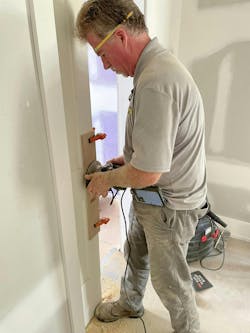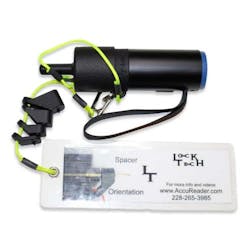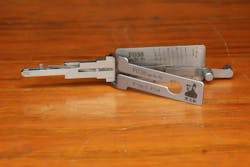Tool Talk: What’s In Your Toolbox?

Every locksmith has a favorite tool in their arsenal, and having the right tool for the job can save time, money and effort. Steve Kaufman talked with New Jersey locksmith Bob Cornine about some of his must-have tools.
Locksmith Ledger: Let’s begin with a little background. How did you get started in the locksmith industry?
Bob Cornine: I started working for Cy Drake Locksmiths in 1977, working for Hank Printz. He was involved with ALOA and was big on education, so it was a great place to start. He’d send us to conventions every year and we’d spend the week attending classes.
LL: Was locksmithing something you were looking to get into?
BC: His shop was a gas station that they converted to a lock shop, so I actually began by pumping gas. I worked with a friend from school, and he worked inside. Hank was very into being clean and organized and that was my friend’s job. After my friend left for college, I took over his job inside. Someone else left and I started doing inventory, receiving boxes and looking up prices and part numbers. Then somebody else left and I moved into doing bench work and waiting on customers. Someone else moved on and eventually I was working on the road. After 11 years at Cy Drake’s, I bought my own place.
LL: Forty-seven years later you’re president of the South Jersey Locksmith Association (SJLA) and doing a terrific job, I might add.
BC: I was involved with the Masters Locksmiths Association of New Jersey for 20 years. I went through various positions there. For two years I was convention chairman.
LL: I’ve always heard that what separates us humans from the rest of the animal kingdom is our ability to use tools. Favorite and useful tools is the focus of this conversation. Had you already been familiar with tools and working with your hands before you started pumping gas at Cy Drake’s?
BC: My father worked for the phone company, so he’d bring home phone stuff like cable with a hundred strands of wire inside or telephones with bell mechanisms we’d take apart. We were always fixing stuff. He also had a side thing going with a woman who did home repair. Tenants would move out and we’d go in and do the necessary repairs. We even had a tire changer in our garage.
LL: How important is having the correct or good quality tools for you as a locksmith?
BC: Every trade has its specific tools. In locksmithing, we start off with the basic hand tools, screwdrivers, pliers, chisels. Most installations begin with these. Plug-in tools transitioned to battery-operated ones like drills and the lights we’d use to look inside car doors. We used to have an HPC curved pick and a tension wrench to pick locks with. Now we have Lishi picks that have become common for most locksmiths. Someone somewhere is working on picks for everything we work on. In our trade we’re not doing too much with electronics and still working with mechanical stuff for the most part.
LL: It seems like the more advanced tools would enable more people to become part of this profession.
BC: You don’t have to technically learn how to pick a lock anymore. Put in a Lishi and it shows you the exact spacing and depth which eliminates a lot of the guesswork.
LL: When I worked as a locksmith during the late ’70s, I don’t remember having all the jigs, etc. to do fresh mortise lock installations, for example.
BC: Back then we had Keefe’s Lock in Trenton, who make all kinds of installation aides, templates, etc. They had aluminum plates you’d attach to the door and run a router around it and take out an old mortise lock and put wooden plugs in there and glue and refinish so you could re-drill for a regular cylindrical or tubular lock. We had a Keefe installation jig for doing Baldwin mortise locks that probably weighed 70 pounds. You could do the installation in 1-1/2 hours. These tools helped you do an exact installation without having to freehand anything.
LL: So, this is an example of a tool being designed based on need. I worked briefly with a guy who’d wrap open cylinders and a coffee can was his pin kit. Do tools like shims, for example, save lots of time?
BC: Sometimes you just keep doing things the way you originally learned. Without a follower, you can use a ½” drill bit. I was lucky to work for Hank Printz, who was so into education and provided us with the right tools. The guy I eventually bought my shop from started in the 1950s and was smoking keys with a match to prep a key for impressioning. He didn’t have the nice installation jig, for example, so you learn to work with what you have. Cut out and then do the rest by hand with a chisel. This takes time and that’s what it’s about – having the right tools to get things done quickly so you can move on to the next job.
LL: What about any tools that you couldn’t imagine being without?
BC: Currently, the biggest one is the LockTech Kwikset SmartKey Decoder. It has a little camera built into it. It goes in the keyway and looks at 90 degrees by a mirror to look at the tumblers. It’s Wi-Fi to your phone. You slide the Kwikset blade in and first you see the fifth tumbler, a picture of it on your phone. You compare it to the 6 depths they show you. Go backwards from fifth to first until you have all the cuts. I use it for every Kwikset SmartKey lock since you can’t pick them. Some people say they can, but I don’t have the time to prove I can. Kwikset came out with a new GEN 5 key, so they came out with a modified tool for it. There are people out there who spend their time inventing tools like this, and it makes our jobs much easier. For about $350 it seems silly to not buy this since it’ll pay for itself after a few lockouts. That’s always the question when you’re not sure if you should spend the money on a tool; how long will it take to get the money back?
LL: Have you made any tools yourself for a job?
BC: I did a job for a custom home builder here on Long Beach Island (New Jersey) and they had 15 pocket doors. He needed custom cut-out for Emtek locks. I had no jig for it and found a guy on YouTube who showed step by step how to make the jig. It was MDF, medium density fiber board instead of plywood and crazy glue. I put all the pieces together and had a jig to cut out 15 doors for the guy. I made it but, in this case, YouTube was the tool I used.
LL: How about automotive locksmithing? Are you doing any?
BC: For several years I was out of the trade and didn’t think I’d be back. It was about the time when chip keys were becoming the norm so after 6 years I’m working my way back into it. First, I bought the Autel IM608 programmer and since I’m also a car mechanic, I use it for other diagnostics.
LL: In spite of being somewhat mechanically challenged, I was pretty good at automotive locksmith work back during the ’80s when most of the work involved picking, impressioning, etc. I remember when the big changes were a horizontal linkage on the doors and a hardened screw securing some ignitions. Do you remember the tools you used back then that made life easier?
BC: With all the education we had early on, we learned how to impression and only needed a vise grip, file and key blank. When we couldn’t use a Slim Jim, we had the air wedge to help see inside the door and work the linkage and we had the long reach tool that the tow truck drivers use. Then we had the Lishi picks to open and then be able to cut the key if needed.
With automotive, it seems like you need to specialize since there’s so many fobs, keys, etc. You can’t do them all with one programmer, so you need at least two, and now there are cars that require you to remove a board to get to a chip, passcode, etc. If you mess up badly, it’s your responsibility and you own it. It’s like when you install a Charly Bar on a patio door and break the glass; I’ve done that a few times. Once I took off a Kawneer closer and left the door to get something out of my truck. The wind blew the door and glass shattered. Now you have to worry about the computer in a car. Mess it up and you pay to have it towed to the dealer and that’s because you didn’t do the research to have the knowledge and the proper tools.
LL: Do you remember learning to install locks and wishing you had a tool to do something?
BC: I remember having a Kwikset or a Schlage jig. If you had a Kwikset jig, you could do the 5-inch backset which was popular back then. If you had the Schlage one, then you had to figure out how to measure, mark and drill the door. I live in a shore community, so everything here is rust and rot, so they now make rot resistant frames which are plastic. How do you chisel out plastic?
LL: Sounds like a job for a drive bolt.
BC: I’m not a big fan of drive bolts. If the edge of the door is plastic, I can go very carefully with a wood chisel; once you get your edge marks you can do that. Ryobi makes a jig for the edge of the door to router out. You put it on the door, and you drill your edge hole and put the jig on there and it pilots itself on that hole. You take it out and use your battery router and it’s done. Instead of taking 5 or 7 minutes to chisel, you have it done in 20 seconds because of the tool you used.
LL: How’d you deal with the frame in this situation?
BC: As locksmiths we always have a tool in our head we want to invent and when I retire at the end of the month, I’m going to work on inventing something. There is a company that makes a router template for the door frames with a few different sizes that you nail on, but the nail doesn’t always work because it pushes the plastic instead of going through. You don’t know what’s available until you ask people. That’s one of the benefits of a locksmith association; we talk and compare notes and help each other. One little tool or idea can make a huge difference.
LL: Like many things, there seems to be a sort of evolution process when it comes to tools. My understanding is that locksmiths were initially part of the machinists’ union(s).
BC: I was working at the Fort Dix army base and the locksmith there was the machinist. Because we deal with thousandths of an inch, that’s machinist work. I’m finishing my career now as a locksmith for the FAA Tech Center. The locksmith there was in the machine shop and had access to whatever he needed. They’d make him fixtures for installing Simplex locks. Just give them the paper template that came in the box, and they’d have a fixture made that you’d put on the door and mark the holes and it’s done.
So many things can be done like door closer templates; put it on magnetic sign material so all you have to do is stick it on the door and not worry about tape. Repetitive stuff needs tools like that. We’re doing a job now that involves digital cabinet locks. At the air Marshall training facility, there are pistol lockers. We’re going to install about 400 of these so I made a template with cardboard – simple and will save lots of time. Even a battery-operated vacuum is a great tool. It makes cleaning up easy, and you look like a professional instead of using a broom and dustpan. After using it, I’ll ask the customer to please not tell my wife how nicely I cleaned up.
LL: Do you think a really good set of tools could help someone who’s mechanically challenged as opposed to a really handy person with limited tools?
BC: Think about drilling a hole through a door. I worked with a guy who couldn’t drill a straight hole in order to install a door viewer. Having a drill that somehow kept it level would be really helpful. It’s about efficiency; if you need to be efficient and it’s how you earn your income, then you need tools that help you do that. Auto mechanics use battery powered drills now instead of pneumatic ones. You don’t have to lug around the air line. For some, the battery-operated pick guns work well.
LL: What about sites like YouTube; a good tool for us?
BC: YouTube is unbelievable and helpful but can also be a killer for our trade because everyone thinks they could do it themselves. You get to a Kwikset lockout, and you get your Lock Tech tool ready. You realize the door is all chewed up because they watched a video about using a credit card to open it. I have used YouTube to learn something quickly; there’s a video for everything. I occasionally get a call for older vintage cars. I was called to make keys for a ’71 Chevy Nova, the one with the spring-loaded ignition switch and the cowboy hat glove box lock. Someone asked if I had to order the keys for the customer and I explained that you can pull the steering wheel, etc. and they said wow! The young ones can’t work on the old stuff; they’re too young. They want to be able to plug in a programmer to make a key. You need the right tool for the job. You may have to go search for the old steering wheel puller and plate compressor, but you’ll be able to do that job because you have the tools and know how to use them.
LL: Have computers proven to be a worthwhile tool in our industry?
BC: When I worked for Hank Printz back in the day, he had an Apple 2+ computer and he wrote the software we used for our annual locksmith conventions. We printed out the badges and tracked all the money. It was the late 1970s and we had computers in the shop, and he came up with a master keying program. Remember back then we had to handwrite the whole system over many pages. In this case the software becomes the tool that saves lots of time. Now you can enter a code into an app on your phone and get the code card to use and the cuts. That’s an impressive tool that most of us take for granted.
An important part of this industry is being able to invoice your customers efficiently. A typical job for me with one of the national service providers: you get a ticket, and you go to the site. Then you check in, take pictures, do the work and then take the after photos. They sign off and then you go back to the shop and upload the photos. This is made possible by the computer, scanner, etc.
Your phone is full of research material, photos, videos, etc. of previous jobs or a how-to video.
LL: How about something as simple as removing the screw on back of a cylinder? Do you have a favorite tool for holding down the pin while unscrewing the cap?
BC: I have a follower with that pattern that pushes down and unscrews the cap. Recently I worked on a pushbutton combo lock I needed to key to other Kwikset locks, and it had smaller diameter pins in it. I’d already dumped the pins into my brass bucket so I couldn’t reuse them. I had to put another lock on the door since I couldn’t do anything else with it. Sometimes you just have to eat it; you take something apart you can’t put back together. Builder’s hardware can be a killer for us since you can get everything from the big box stores where locks can be bought for less than what I’d pay for it. I’m in a shore community with million-dollar houses and the owners rent them out; rental season helps pay the year’s mortgage. Because of Hurricane Sandy, many of the houses got wiped out and many were rebuilt with lots of new Schlage and Kwikset. The lock might have a list price of $700 but it’s available at Home Depot for $189. You mark it up a little, but you can’t get anywhere near the list price.
LL: How does having the right tools figure into this?
BC: Do-it-yourself people typically don’t do anything with the door frame. Often times the hole in the frame isn’t deep enough for the bolt to extend all the way. I can tell by using my pointer finger. If it doesn’t go in the hole past the first joint, it’s not drilled deep enough. The finger is my tool in this case. It should extend out an inch, the size of the typical finger, up to the joint. If the door is kicked in because the long screws weren’t used or the bolt wasn’t fully extended, the insurance company will deny your claim. My point is that the homeowner won’t bother since they don’t know and most likely don’t have the tools. I’m the professional who will put in the 3” screws because I do have the right tools for the job.
While I’m installing the lock, I get them to download the software. They get very excited about what they can do with the buttons and how they can unlock it from anywhere in the world. Then when it’s done, they can Venmo the payment to me.
How many locksmiths carry replacement batteries with them? Someone comes down to the shore and can’t get in because the batteries died, and the override key is in the house. I have a Battery Daddy, a caddy case that covers all the batteries you’d need. I’m thinking about providing a service to the people who don’t come to their house often. I’ll come out twice a year to replace the batteries. We don’t have much recurring revenue in the lock industry, so what can I offer that way?
LL: What’s the most important tool we have?
BC: Knowledge. If you don’t keep learning about the new stuff coming out, then you can’t be the expert and get paid for it. Attend classes, talk with fellow locksmiths in trade associations. Everyone else in your association is a potential tool for you to use. Look at some Facebook locksmith pages and how much some seem to enjoy belittling the guy who asks a simple question. We don’t do that in associations. As good as you might be, you don’t know it all, so education is the most important tool you have at your disposal.
About the Author
Steve Kaufman
Steve Kaufman has worked for distributors in the locksmith industry since 1993 and worked as a full-time locksmith from 1978 through the 1980s. Kaufman is the sales manager for IDN Hardware out of its Philadelphia location.


